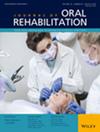Relationship Between Oral Thickness Perception and Food Dynamics During Liquid Swallowing in Healthy Young Adults
Abstract
Background
The swallowing reflex is a coordinated movement controlled by motor and sensory functions of the oral cavity and pharynx. Swallowing patterns are adjusted through peripheral nerve stimulation and central afferent input, which are associated with food properties. Notably, in older adult care, thickeners are included in liquids to slow pharyngeal transit and improve swallowing safety. Therefore, perceiving liquid viscosity may affect swallowing control and safety. However, it remains unclear whether changes in food dynamics owing to varying viscosity are passive or adaptive.
Objective
To investigate the relationship between oral thickness perception and food dynamics during liquid swallowing in healthy young adults.
Methods
Participants were classified into high- and low-sensitivity groups based on their thickness discrimination ability score recorded through a sensory test using eight thickened water concentrations. The flow velocity spectrum was recorded while water and three thickened water concentrations were ingested using the pulsed Doppler mode of ultrasound imaging. The maximum pharyngeal transit velocity, mean pharyngeal transit velocity, pharyngeal transit time (PTT) and flow velocity spectrum area were calculated using the flow velocity spectrum. The Wilcoxon rank-sum test was used to compare the parameters between groups.
Results
The high-sensitivity group showed a significantly lower standard deviation of PTT when swallowing 2.0 wt% thickened water compared with the low-sensitivity group (p < 0.05).
Conclusion
Individuals with high thickness sensitivity can perceive food properties accurately, adjust their swallowing movements accordingly, and perform stable swallowing consistently.


 求助内容:
求助内容: 应助结果提醒方式:
应助结果提醒方式:


